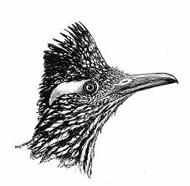The New Mexico Ornithological Society (NMOS) is pleased to announce two recipients of the 2009 Ryan Beaulieu Research Grant. Each received $1000 to support their research on New Mexico birds.
Ryan Beaulieu Research Grant
Raymond VanBuskirk, Central New Mexico Community College, and
Michael Hilchey, Albuquerque High School – Rosy-Finch Project
For the past six winters we have been conducting research, by means of banding and radio tracking, on the wintering Rosy-Finch population at the Sandia Crest. To date we have banded over 1900 Rosy-Finches of all three species and have begun to answer questions about site fidelity, breeding ranges, flock composition, and age and sex ratios. This past season we have developed two more questions: one regarding the development of more accurate sexing criteria and one regarding the roosting habits of Rosy-Finches. We have found many birds showing intermediate plumage characteristics that are difficult to sex. We have also found previously unrecognized characteristics that correlate well with other documented sexing criteria. However, we have not been able to validate these new techniques with definitive, accurate sexing methods. DNA analysis would be a solid means of determining the sex of birds without having to collect specimens. Beginning in 2008-2009 we have been using radio transmitters to determine winter roost sites. The funds from this grant will be split to pay for DNA analysis studies in collaboration with Dr. Christopher Witt (Museum of Southwestern Biology) and acquiring more radio transmitters.
Ryan Beaulieu Research Grant
John Coffman, New Mexico State University – Breeding bird diversity
and density in creosote (Larrea tridentata) shrublands treated with
herbicide
In less than 150 years, large areas of perennial grasslands in southern New Mexico have transitioned to shrublands dominated by honey mesquite and creosote. The worldwide pattern of shrub encroachment into arid and semiarid grasslands has negatively impacted multiple ecosystem services and may alter the diversity and density of bird species. In an effort to restore grasslands in southern New Mexico, Restore New Mexico, a partnership with the Bureau of Land Management, ranchers, and conservation groups, has enacted an aggressive and ambitious strategy. This strategy includes the application of herbicide on hundreds of thousands of hectares of shrublands. Avian assemblages often reflect the assemblages of plant communities and therefore, measuring avian response may serve as an indicator of the effectiveness of landscape-scale herbicide treatments. The objective of this study is to quantify the effect of herbicide treatments on breeding bird densities and species diversity in creosote shrublands. Breeding bird surveys will be conducted on shrublands treated 25 years ago and others treated 5 years ago. Study sites are located north of Deming, the eastern edge of the Mimbres Mountains, and the western edge of the San Andreas Mountains. They will be paired with nearby untreated control sites. Funds from this grant will be used to support travel to and from research sites in an NMSU vehicle.
